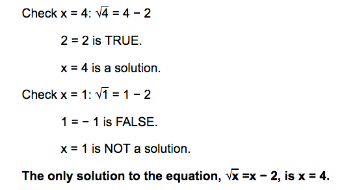Section 3: Solving Radical Equations
It is important that you watch the video first.
Solving Radical Equations
Step 1. Isolate the radical. Make sure that one radical term is alone on one side of the equation.
Step 2. Apply the Power Rule. Raise each side of the equation to a power that is the same as the index of the radical.
Step 3. Solve the resulting equation. If it still contains a radical, repeat Steps 1 and 2.
Step 4. Check all proposed solutions in the original equation. In some cases, one or more proposed solutions will be extraneous and will need to be rejected.
Example 1. Solve the equation.
√x =x − 2
Solution.
The radical term is already isolated on the left side of the equation. Remove the radical by squaring both sides of the equation.

Solve the equation by moving all terms to the right side and factoring.
0 = x2 − 5x + 4
0 = (x − 4)(x − 1)
x − 4 = 0 or x − 1 = 0
x = 4 or x = 1
Check both possible answers to see if they satisfy the original equation.

Check x = 4: √4 = 4 − 2
2 = 2 is TRUE.
x = 4 is a solution.
Check x = 1: √1 = 1 − 2
1 = − 1 is FALSE.
x = 1 is NOT a solution.
The only solution to the equation, √x =x − 2, is x = 4.
Test Your Knowledge by opening up the Test Yourself Activity.

